After a 5-0 win over the Detroit Red Wings at Scotiabank Arena on Saturday night, there was a seemingly endless string of positives to reflect on for the Toronto Maple Leafs as they finished off the preseason.
The power play was lethal, scoring on three of four opportunities, all of the goals coming within an eight-minute, second-period flurry. Defence and goaltending were both pristine, limiting the Red Wings to just 16 shots as Frederik Andersen put up another shutout. And the stars all looked just as dominant as you’d expect: Auston Matthews tallied a goal and two assists, John Tavares picked up a goal and assist, while William Nylander and Andreas Johnsson both scored once.

But perhaps more surprising – and interesting – was the emergence of the Maple Leafs’ depth, not only in Saturday night’s victory but over the course of the entire preseason.
“We’ve made some real good additions obviously this summer,” head coach Mike Babcock said after the game. “(Ilya) Mikheyev has a chance to be a real hockey player.
“I think the growth of a guy like (Rasmus) Sandin is real. (Trevor Moore) looks like a hockey player now which is positive. (Frederik Gauthier) is way better which is positive.”
The 24-year-old Russian has been particularly intriguing. Mikheyev spent the last four seasons in Russia’s Kontinental Hockey League (KHL) before signing a one-year deal with the Maple Leafs this summer. He scored 23 goals and 45 points in 62 games for Omsk Avangard, while adding another four goals and 11 points in 13 playoff games.
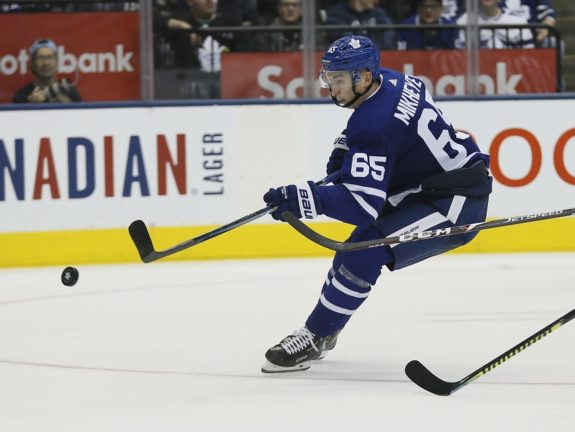
Expectations for the 6-foot-2 winger were ratcheted up when his agent, Dan Milstein, took to Toronto airwaves and claimed that Maple Leafs fans would be “in for a real treat” with Mikheyev.
He hasn’t found the score sheet yet, but through four preseason games, it’s clear that the KHL import has become more confident with each passing period. He tallied 10 shots and eight scoring chances through the pre-season and even showed some utility by playing on the special teams.
“You saw him create a couple of dangerous chances today when he’s flying down the wing,” Nylander said Saturday night. “For sure he’s grown. He can (penalty kill) for us too so he’s a good player.”
It wasn’t the first time that the new Maple Leaf earned praises from his teammates, either.
“He plays a lot like Pavel Datsyuk,” Matthews said of Mikheyev the week prior, following the Maple Leafs 3-0 win over Buffalo on Sept. 20. “He’s got that reach and he’s kind of got a similar paddle on him. He uses a long stick and he’s really lanky. He’s really shifty, strong on the puck, really good on his edges.
Projections and Comparables
The Datsyuk comparable may be a bit of a stretch, at least in terms of offensive talent and production. But just how much should Maple Leafs fans expect from Mikheyev in his first NHL season?
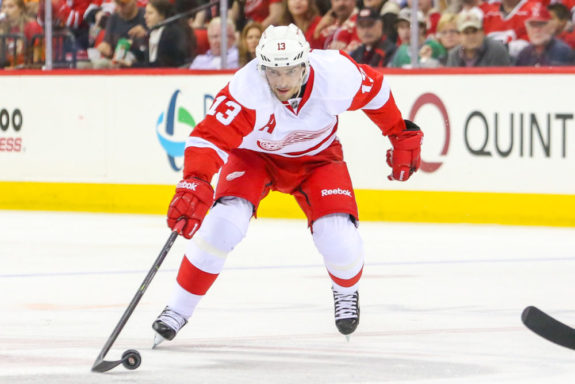
The lanky winger finished 20th in points, but more impressively, sixth in goals last season in the KHL. Mind you, he finished behind several players that never really cut it in the NHL: Nigel Dawes, Vadim Shipachev, Mikhail Grigorenko, and Linus Omark just to name a few. But while skilled players like Shipechev and Omark couldn’t hang in the NHL, there’s a reason why Mikheyev might be different. We’ll touch on that in a bit.
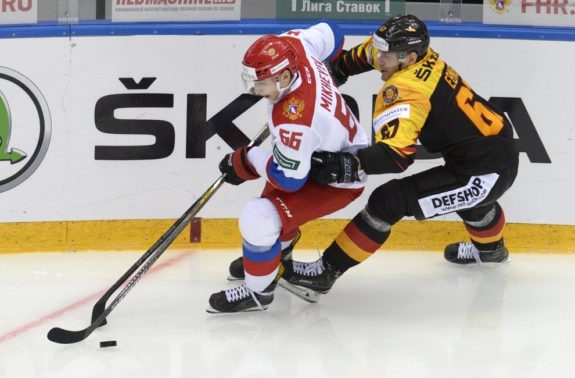
The Artemi Panarin comparable has been thrown out there in regards to Mikheyev, and although it sounds crazy at first, it’s not totally absurd. In his age 22 season, Panarin scored 40 points in 51 games (0.78 PPG), then really exploded in his age 23 season, posting 62 points in 54 games (1.15 PPG). By comparison, the Maple Leafs winger scored 38 in 54 as a 23-year-old (0.70 PPG), then saw a modest increase to 45 points in 62 games as a 24-year-old this past season (0.73 PPG). Their goal scoring records are even more similar: Mikheyev averaged 0.36 goals per game in his last two KHL seasons, while Panarin averaged 0.44.
In short, the Maple Leafs are essentially looking at a player that was about as productive as Panarin was when he was 22 – right before he broke out and emerged as a star in the KHL, then did the same thing in North America. The breakout part is the key qualifier, though. Turning 25 in October, Mikheyev is a year older than Panarin was when he made the move, but the former hasn’t yet reached that next gear offensively. There’s a chance he can still find it, but the more likely scenario is that he is what he is. That’s not a bad thing, but don’t expect a superstar.
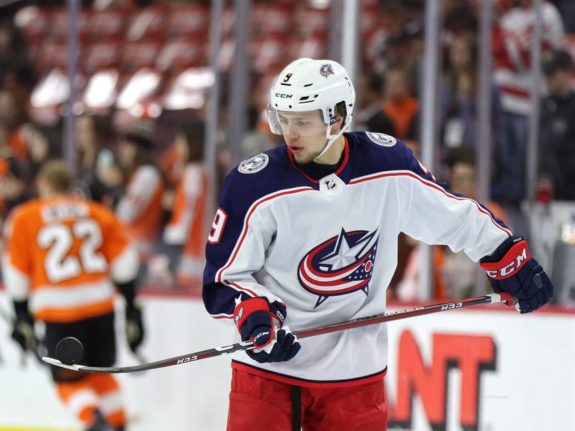
Perhaps the main reason why Mikheyev will be useful for the Maple Leafs is that, unlike other KHL stars who have failed to stick in the NHL, he has incredible utility. He’s the type of player who can play up and down a lineup and fit in almost anywhere thanks to his unique combination of skill, speed, and size. He’s also the type of player that Babcock loves because he “plays the right way” as the bench boss would say. As we saw in the preseason, he can also be used on the penalty kill, which makes a lot of sense given his talents. His long reach and speed will challenge opposing power-play units and should even create some chances going the other way.
Ice Time and Usage
Going hand in hand with point production, Mikheyev’s deployment will be important. Obviously players who are given more ice time and better linemates tend to put up bigger numbers.
Mikheyev looks to be pencilled in on Toronto’s third line alongside Moore and Alexander Kerfoot to start the season. It’s a third line with some skill to be sure, but I wouldn’t necessarily call it a scoring line.
Moore has just 25 games of regular-season experience, all coming last year with the Maple Leafs. He scored two goals and eight points in heavily sheltered fourth line minutes, playing under nine minutes per night. Surprisingly, Moore ranked 62nd among forwards last season in points per hour at 5-on-5 – essentially the scoring rate of a second line player: his 2.19 P/60 was equal to Teuvo Teravainen and better than Mikko Rantanen. It’s not wild to imagine that with more ice time and better linemates, Moore could see a significant uptick in scoring.
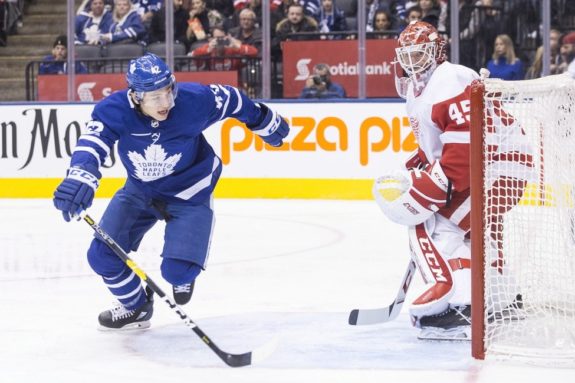
Kerfoot looks less impressive at 5-on-5, ranking 199th in P/60 (1.62) over the last two seasons in Colorado. He played mostly on their third line, averaging just over 11 minutes per game at 5-on-5. Based on his scoring rate, he looks like a lower-end, third-line player. Where Kerfoot really does his damage is on the power play as he jumps up to 39th among forwards in the past two seasons (5.54 PPG).
Looking at Toronto’s ice time allotment last season, the third line played about 12 minutes at 5-on-5, but that was when they had Nazem Kadri. This season there is some expectation that both Matthews and Tavares will demand more ice time, which could mean that the third line sees a slight decrease to around 10 or 11 minutes.
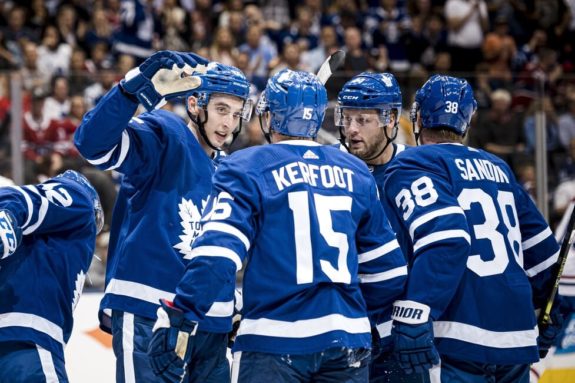
Ultimately that means Mikheyev won’t see a ton of ice time in his first season. If he does penalty kill regularly, he’ll get some extra shifts there, but should still end up in the 12-13 minute range. And playing with what could be considered prototypical third-liners in Moore and Kerfoot, we shouldn’t expect huge offensive numbers.
Nevertheless, the Russian winger will be an intriguing player to watch for the Maple Leafs this season, especially down the stretch as he gets accustomed to the NHL game. And for a team that’s sometimes struggled against physical opposition like the Boston Bruins, Mikheyev’s size and strength could certainly be a factor come playoff time.
Player stats from https://www.quanthockey.com/ and http://naturalstattrick.com/